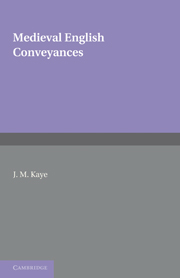Book contents
- Frontmatter
- Contents
- Preface
- Abbreviations and references
- List of year book cases
- Introduction
- 1 Common clauses in deeds
- 2 Grants in fee: general
- 3 Grants in fee: special cases
- 4 Grants in marriage, limited fee and fee tail
- 5 Grants in alms
- 6 Women's realty
- 7 Confirmations
- 8 Grants for life and for lives
- 9 Grants for terms of years
- 10 Rents
- 11 Exchanges
- 12 Surrenders and releases
- 13 Villeins and their lands
- Glossary of legal terms
- Select Bibliography
- Index
10 - Rents
Published online by Cambridge University Press: 29 January 2010
- Frontmatter
- Contents
- Preface
- Abbreviations and references
- List of year book cases
- Introduction
- 1 Common clauses in deeds
- 2 Grants in fee: general
- 3 Grants in fee: special cases
- 4 Grants in marriage, limited fee and fee tail
- 5 Grants in alms
- 6 Women's realty
- 7 Confirmations
- 8 Grants for life and for lives
- 9 Grants for terms of years
- 10 Rents
- 11 Exchanges
- 12 Surrenders and releases
- 13 Villeins and their lands
- Glossary of legal terms
- Select Bibliography
- Index
Summary
The principal division of rents, at common law, was into those which were rents service and those which were not. A rent service was a rent of money or other fungibles, reserved by a lord when he granted real property to a free tenant. This kind of rent, for the levying of which the lord had by common right a power to distrain, has been discussed in chapter 2. The present chapter is concerned with rents which were not rents service, that is, rents in the case of which the person entitled to receive the rent was not the lord of the land from which the rent issued. There was no common right to distrain in the case of such rents. A right to distrain arose only if it had been expressly granted, either by the person creating the rent or by the tenant of the land charged with the rent. Such a right could be granted not only at the time when a rent was created or transferred, but at any later time by the person seised of the charged land. Normally the power to distrain was exercisable only on the land from which the rent issued, but the grantor of the rent might grant a power to distrain in other land which he owned. Rents without a power to distrain existed in large numbers in the thirteenth and fourteenth centuries, and were particularly common in boroughs, where both rich burgesses and religious houses accumulated large numbers of such rents by gift, exchange or purchase.
- Type
- Chapter
- Information
- Medieval English Conveyances , pp. 278 - 300Publisher: Cambridge University PressPrint publication year: 2009

